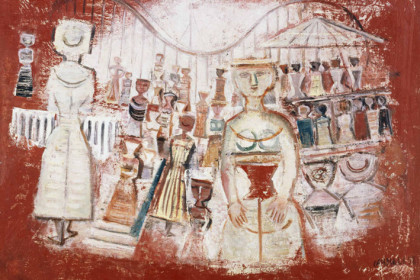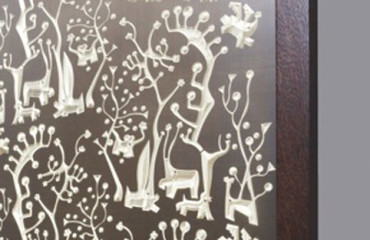
These motionless figures appear like archetypes, distant, untouchable: they are Campigli’s women, female beings that have always existed in Western art, familiar to us because they remind of suggestions and images ranging from portraits of Fayum to Greek korai, from Etruscan funerary sculptures – the painter was struck by Etruscan art during a visit to the collections of Villa Giulia in Rome in 1928 – to the monumental terracotta by Arturo Martini, amazing sculptures of the Thirties of the XX century, coincidentally contemporaneous paintings by Campigli.
Infinite, elegant, bejeweled but boxed in hives, framed claustrophobically on theater stages and in subway wagons, or still hovering on the threshold of a door that they will not ever cross, female figures are absolute protagonists of 80 paintings on display in an exhibition at the Fondazione Magnani Rocca which investigates carefully and gently on the often forgotten painter’s work. The General Catalogue edited by Archives Campigli intervened, to remember him, in recent months edition, and has allowed us to trace the intriguing and poignant story of an artist – appreciated even by Margherita Sarfatti, who welcomed him into the group “Novecento” which Mario Sironi was part of, to give just one example – who participated in the climate of artistic ferment of the first half of the last century. The solid and, even in the uniformity of the subjects chosen, never predictable poetic thanks to an “anthropological” and social approach, is combined with earthy and dusty tones, with Etruscan ochres relieved here and there by bright blue.
Massimo Campigli, Italianate name because of German origin, was born in 1895 by a young mother who, to cover the scandal of a son born out of wedlock, moved with the women of the family in the Florentine countryside, where the little boy grew up in the belief that his mother was his aunt. He discovered the deception only in adolescence and never denied to no longer be able to disengage from a childish dimension – “I have never taken refuge in dreams, in infantilism, I simply stayed there” – a universe populated by women, of mother goddesses and feminine idols increasingly depersonalized and closer to a primitivism of spontaneous and yet serene flavor. Replicated by the faces and geometric bodies, almost like hourglasses, reference to Freud’s psychoanalytic theories is not only inevitable, but also first-hand, since Campigli read the work of the great scientist in original language. A discreet man of culture, refined writer and columnist for “Corriere della Sera” in Milan and Paris – the city where the beating heart of the Back to the order movement of the renewed dialogue with the classicism which runs Europe’s first post-war period – he took refuge in the mystery of his origins and found sap for an obsession towards painting that occupied him throughout his life.
 English
English  Italiano
Italiano 



